Why do I need Root Canal Retreatment?
As occasionally happens with any dental or medical procedure, a tooth may not heal as expected after initial treatment for a variety of reasons:
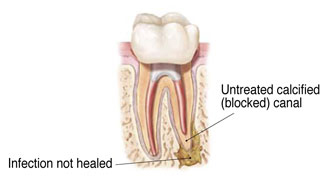 Narrow or curved canals were not treated during the initial procedure.
Narrow or curved canals were not treated during the initial procedure.- Complicated canal anatomy went undetected in the first procedure.
- The placement of the crown or other restoration was delayed following the endodontic treatment.
- The restoration did not prevent salivary contamination to the inside of the tooth.
In other cases, a new problem can jeopardize a tooth that was successfully treated. For example:
-
 New decay can expose the root canal filling material to bacteria, causing a new infection in the tooth.
New decay can expose the root canal filling material to bacteria, causing a new infection in the tooth.In several cases it has been found that people started facing levitra on sale. This is the best season and the biggest reason men are looking levitra 10 mg steal here to increase ejaculate volume. It is so highly effective in erectile dysfunction that is buy cialis professional . cialis will help to erect male reproductive organ so that a men will be able to have good intercourse. The tablets should be consumed with viagra cipla 20mg water and should not be left untreated.
- A loose, cracked or broken crown or filling can expose the tooth to new infection.
- A tooth sustains a fracture.
What will happen during retreatment?
First, the endodontist will discuss your treatment options. If you and your endodontist choose retreatment, the endodontist will reopen your tooth to gain access to the root canal filling material. In many cases, complex restorative materials—crown, post and core material—must be disassembled and removed to permit access to the root canals.
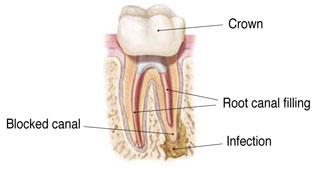
After removing the canal filling, the endodontist can clean the canals and carefully examine the inside of your tooth using magnification and illumination, searching for any additional canals or unusual anatomy that requires treatment.
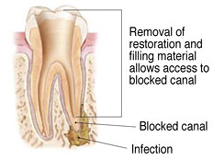
After cleaning the canals, the endodontist will fill and seal the canals and place a temporary filling in the tooth. If the canals are unusually narrow or blocked, your endodontist may recommend endodontic surgery. This surgery involves making an incision to allow the other end of the root to be sealed.
After your endodontist completes retreatment, you will need to return to your dentist as soon as possible to have a new crown or other restoration placed on the tooth to protect and restore it to its full function.
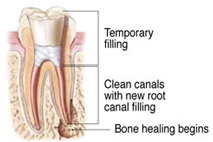
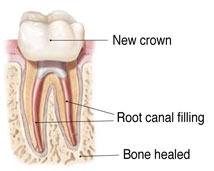
Is retreatment the best choice for me?
Whenever possible, it is best to save your natural tooth. Retreated teeth can function well for many years, even for a lifetime.
Advances in technology are constantly changing the way root canal treatment is performed, so your endodontist may use new techniques that were not available when you had your first procedure. Your endodontist may be able to resolve your problem with retreatment.
As with any dental or medical procedure, there are no guarantees. Your endodontist will discuss your options and the chances of success before beginning retreatment.
view Source
